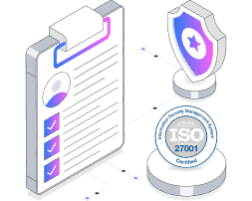What Is Automotive Device Security? Key Threats and Solutions In 2025
As of 2025, the global automotive industry is more digital than it has ever been, with nearly 85% of new vehicles featuring internet connectivity and advanced driver-assistance technologies. Cars are now considered computers on wheels, with features such as autonomous driving, smart infotainment, and more. While the cybersecurity in automotive industry has made this shift toward software-defined and connected vehicles, there are severe cybersecurity risks. Automotive device security focuses on the security of the electronic systems, control units, and communication networks of vehicles, and it is now a priority for automakers, technology vendors, and regulators. As the complexity of cyber threats rises, it has become imperative to secure these digital software-enabled components to ensure safe operation, privacy, and reliability in the long run when driving on the road. Understanding Automotive Device Security Automotive device security protects the electronic systems and components inside the modern-day personal vehicle from cyber-related threats and attacks. As automobiles become more connected and reliant on software, the need to secure our devices is more important than ever. These devices include everything from the core control units managing the engine and braking system to the entertainment screens in your dashboard. Key Components Covered: Key components that need protection are: Why Is This Important? It is important to secure these components because vulnerabilities could cause unauthorised access, data theft, or dangerous control over operations. A hacker may find a weak point in the infotainment system and cross over to take control of other important vehicle controls or steal sensitive user data. Therefore, automotive device penetration testing is important to ensure vehicle safety, privacy, and reliability to protect vehicles and their passengers as well as the transport ecosystem as a whole. Key Threats to Automotive Device Security There are four main types of threats to automotive device security, including remote cyberattacks, ransomware, supply chain vulnerabilities, and insecure communications. These vulnerabilities can lead to unauthorised access, data theft, or access to critical vehicle functions. To formulate successful mitigation strategies, understanding those threats to automotive devices is imperative. 1. Remote Cyberattacks As all vehicles are becoming more and more connected to the internet, hackers are more able to remotely attack critical vehicle systems such as infotainment and telematics. Cybercriminals can attack these systems to gain unauthorised access to vehicle controls or access vehicle owner-operator personal information. Remote hacking is especially dangerous because it may occur and go unnoticed, and the risk of pending vehicle theft or manipulation extends a far greater risk to customers and insurers. 2. Ransomware Attacks Ransomware may cause cybercriminals to lock down vehicle systems or data, and they will demand payment for that data or system to work again. For commercial fleets or manufacturers, such a ransomware attack could result in significant disruptions that include costly downtime and customer loss in trusting the brand. Vehicles are becoming more full of software, and unfortunately, as a software application comes into existence, a larger threat of ransomware follows it. 3. EV Charging Station Vulnerabilities Electric Vehicle charging infrastructure is a new and growing target of cyberattacks. Hackers can take advantage of software flaws in chargers to take over charging stations or sandbox malicious code into vehicles while charging. These vulnerabilities aren’t just a concern for vehicle owners themselves but have implications for the entire EV ecosystem. 4. Supply Chain Attack Modern vehicles are as complicated as they have ever been and require components and software from diverse suppliers. Any potential risk in the supply chain could allow attackers to insert malware or vulnerabilities before the vehicle is assembled. If this takes place and if components get placed into critical parts of the vehicle, that means there are countless repair points resulting in a high landscape of risk that is tough to monitor or to find. 5. Insecure Vehicles-to-Whatever (V2X) Communications V2X enables vehicles to communicate with each other and infrastructure while improving both safety and traffic flow. If the V2X communication channels are not properly secured, attackers can spoof messages or relay false messages, leading to unsafe behaviour and the potential for accidents or traffic turmoil due to the erroneous data they receive. 6. Insider Threats Not all threats come from the outside. Employees or contractors with access to detailed information about the automotive systems may intentionally or unintentionally cause attacks against the systems under their control. Certainly, insider threat is more difficult to identify, even if it was a data leak, sabotage, or safety system in a vehicle. Latest Penetration Testing Report Download Solutions to Strengthen Automotive Device Security To enhance the security of automotive devices, it’s important to implement a combination of the right tools and best practices. Secure software development lifecycle practices, regular penetration testing, robust encryption, and timely over-the-air updates are all made available by these solutions, contributing to safety and reliability on the road and protecting vehicles against evolving cyber threats. 1. Routine Penetration Testing Penetration testing is when an ethical hacker replicates the actions of an adversary by targeting vehicle systems and the vehicle to find exploitable vulnerabilities before others do. Manufacturers appreciate this form of testing because they can identify the potential vulnerabilities related to a specific point in time and to each attack surface, which can lead to a remediation plan, thus reinforcing the defences. In addition, testing is performed periodically, and even when new features or updates appear, they likely change the attack surface and threaten the overall security quotient. How Qualysec Helps: Qualysec utilizes expert-driven automotive penetration testing to find unseen vulnerabilities and protect vital systems. 2. Secure Software Development Lifecycle (SSDLC) Introducing secure practices to the software development process from conception through design and coding, then testing, and deployment minimizes the risk of exposure to vulnerabilities. SSDLC ensures that developers adhere to specific protocols, achieve secure coding specifications and consistently gather security information, making a more secure and stable vehicle software product. How Qualysec Helps: Qualysec ensures secure coding and vulnerability assessments are incorporated into every stage of the software development lifecycle. 3. Encryption and Strong Authentication




